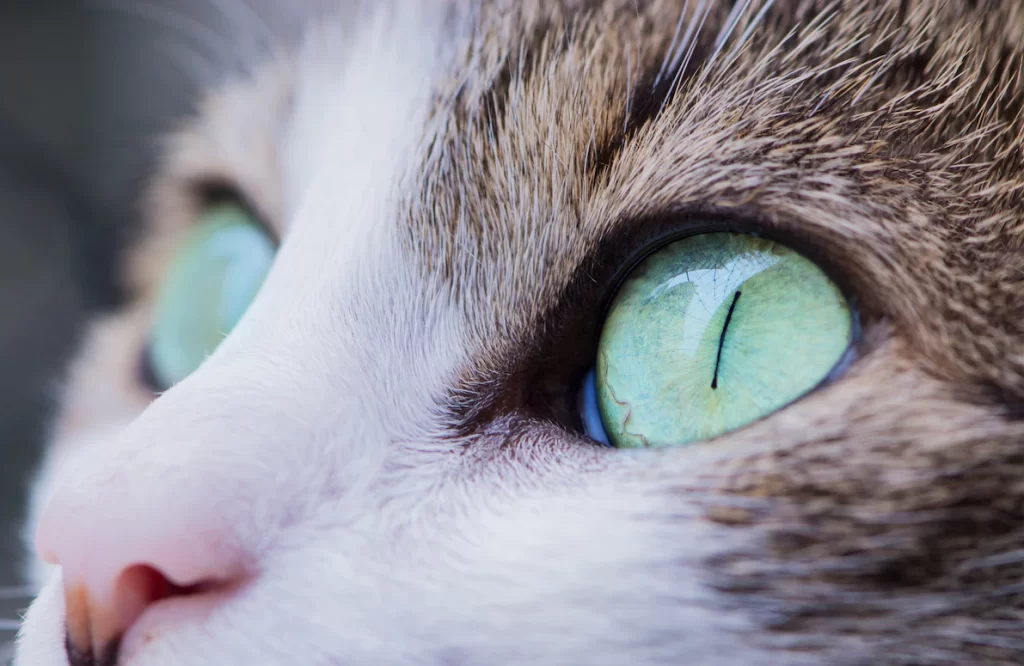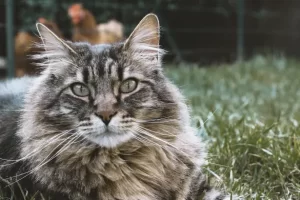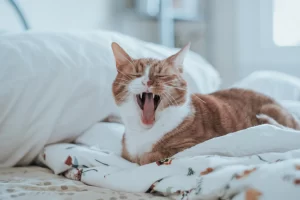Last updated on February 12th, 2023 at 12:55 am

Eye problems in cats are uncommon, but that doesn’t mean they can’t happen. So, the question is, what are the common eye problems in cats? The types of issues seen are frequently age-dependent. Because of their developing immune systems, young cats, for example, are susceptible to specific illnesses such as infections and “cat flu,” which affect the eyes and are frequently viral or bacterial in nature. Older cats, on the other hand, can develop eye ulcers as well as certain types of cancer. Issues in older cats, such as high blood pressure, can have an impact on the eyes, which is uncommon in younger cats. What does it mean when your cat winks, blinks or squints at you?
Discolorations of the white part of the eye, changes in the appearance of the eyelids, and the presence of eye discharge are symptoms of cat eye problems or unhealthy eyes. Furthermore, unhealthy eyes can have different-sized pupils (anisocoria). Cat eye infections are among the most common eye problems in cats. Pet parents should be familiar with their cats’ normal eye appearance. They will be able to detect the presence of eye disorders much more easily this way. In this article, we will discuss all the different common eye problems, along with their symptoms and possible aid.
Common Eye Problems in Cats
As previously stated, common eye problems in cats can vary depending on the age of the cat. So, let’s break down the most common eye problems in cats by problem type, typical symptoms, and treatment options.
#1. Eye Infections
Eye infections may be caused by bacteria or viruses. Because of their developing immune systems, young kittens are more prone to infections, which can cause runny or weeping eyes, green or yellow eye discharge, or squinting. An eye infection is sometimes part of a larger upper airway infection known colloquially as “cat flu.”
Eye infections can be contagious to other cats in the house, so ask your vet if any affected cats should be separated from other healthy cats (or dogs) in the house. The good news is that most eye infections respond well to treatment, which often (but not always) includes antibiotics.
Symptoms
Weeping Eyes, Green / Yellow Discharge, Squinting, and Swollen eyes are the most common symptoms of eye infection.
Treatment
Clean your kitten’s eye with a clean cotton swab damp in water. Do this carefully. However, the best thing to do is rush to your vet so they can give you antibacterial medicines as this can help in reducing the pain as well as fix the whole problem.
#2. Glaucoma
Inside the eyeball, fluid is constantly being produced and draining. When fluid drainage is obstructed, eye pressure rises, leading to glaucoma. Anatomical abnormalities within the eye, infection, inflammatory disorders, trauma, tumors, an abnormal shift in the eye’s lens, and other factors can all cause glaucoma. Cats suffering from glaucoma are frequently in excruciating pain. Their eyes may be red, cloudy, weepy, or visibly enlarged in severe cases.
Glaucoma is a medical emergency. Cats can lose their vision and possibly even their eyes if they do not receive timely treatment with eye pressure medications. If the underlying cause of glaucoma can be identified and treated successfully, glaucoma should resolve as well. When this is not the case, long-term glaucoma medical management is required. If a cat’s glaucoma cannot be adequately controlled, surgery (often to remove the affected eye) may be required to keep the cat comfortable. When a cat’s glaucoma has a genetic basis, both eyes are likely to be affected at some point.
Symptoms
Cats with glaucoma will typically exhibit signs of significant pain, such as eye rubbing and squinting, withdrawal from people, and yowling or crying. Cloudy, runny, or reddened eyes are possible. The eyeball itself may appear swollen in severe cases.
Treatment
If you suspect your cat has glaucoma, take them to the vet as soon as possible. The sooner the increased intraocular pressure can be reduced, the better the chances of saving the eye. Glaucoma resolves itself in mild cases once the underlying cause is addressed, but more severe cases may require ongoing management to prevent excessive fluid buildup. In the worst-case scenario, the eye may have to be removed.
#3. Conjunctivitis
You may come across your cat and wonder, “Why are my cat’s eyes watering?” Alternatively, “Why are my cat’s eyes red?” Alternatively, “Why is my cat’s eye swollen?”. Conjunctivitis is most likely to blame. The majority of cat eye problems are caused by a bacterial infection known as conjunctivitis, also known as “pink eye.” That’s right—the same pink eye that afflicted your elementary school classroom can also afflict your pet. In fact, regardless of how well they’re cared for, most cats will get conjunctivitis at least once in their lives
Symptoms
The conjunctiva—the thin membrane that coats the outside of the eyeball and the inside of the eyelids—becomes irritated during a conjunctivitis infection, causing one or more of the following symptoms:
- The discharge is gooey.
- Blinking excessively.
- Squinting.
The most noticeable symptom is runny eyes. Eye discharge can be clear, grey, yellow, green, or even a dark, rusty red. One or both eyes may be affected, and the inside of the eye may appear swollen and/or reddened. Other symptoms of upper respiratory illness, such as sneezing or nasal discharge, may be present as well.
Treatment
Conjunctivitis is typically treated with topical antibiotics in the form of drops or ointment. If an upper respiratory illness is present, your veterinarian may also treat it. FHV-1, or Feline Herpes Virus, is one type of infection that frequently causes this eye disorder. If this is the case, your veterinarian may prescribe additional treatments to control the virus and prevent future flare-ups.
#4. Uveitis (Eye inflammation)
Uveitis is an inflammation of the eye that does not appear to be caused by an infection. This can happen to both young and old cats, although it is thought to be more common in cats with underlying immunosuppression, such as feline leukemia virus or feline immunodeficiency virus.
The inflammation might cause color changes in the eye or iris, sagging eyelids, or elevation of the third eyelid. It can also leave deposits on the surface of the eye, giving it a rough appearance. Anti-inflammatory drugs are frequently used to treat inflammation, sometimes as eyedrops and occasionally as an oral prescription.
Symptoms
Squinting, Avoidance of bright lights, Closing the affected eye, Cloudy look in the eye, and Change in iris color
Treatment
Treatment is essential since ignoring uveitis can lead to cataracts, glaucoma, and/or blindness in your cat. The treatment aims to relieve the affected eye’s inflammation and discomfort while also treating the underlying systemic condition that caused it. Uveitis should be treated as an emergency, and if it is suspected, your cat should be evaluated by a veterinarian.
#5. Corneal Ulcers
The cornea is the transparent tissue on the surface of the eye that allows light to pass through. Corneal ulcers are open sores on the surface of the eye that is caused by infections, trauma, insufficient tear production, or anatomical eye defects. When a cat gets an ulcer, the afflicted cornea may appear foggy. Eye pain, squinting, redness, and sometimes discharge are also symptoms.
Mild, superficial corneal ulcers normally heal on their own with adequate treatment, which may involve addressing any underlying causes, using antibiotic drops or ointment, and providing pain relief. Deep corneal ulcers may necessitate surgery or other treatments to promote recovery. Without treatment, cats may develop a dead tissue region above the ulcer (called a corneal sequestrum) or, worse, the eye may explode, resulting in irreversible blindness and ugliness.
Symptoms
Signs of corneal ulcers include rubbing and squinting, obvious eye pain, redness, and discharge, in addition to cloudiness in the affected area.
Treatment
Mild ulcers usually heal if the underlying cause is treated, but your vet may additionally prescribe antibiotic ointment or drops as well as pain relievers for your cat. Deep-seated eye ulcers may necessitate surgery. Corneal ulcers are normally treatable with proper treatment, but if left untreated, they can result in permanent blindness and even disfigurement.
#6. Cataracts
The lens is placed in the center of the eye and is generally clear, however a hazy cataract can form on all or part of the lens. Cataracts prevent light from reaching the back of the eye, resulting in blurred vision or blindness depending on the severity of the condition. Cataracts are frequently confused with lenticular sclerosis, a typical aging process that damages cat lenses. Both disorders cause the pupils (the normally black center of the eye) to appear white, grey, or milky, but a standard eye exam can detect the difference.
Symptoms
A cataract causes the eye to seem milky and clouded. Cataracts, on the other hand, are often not apparent until they are progressed enough to seriously impede vision, at which point your cat may exhibit indicators of vision loss, such as bumping into things or moving slowly, particularly in dim lighting. If diabetes mellitus causes cataracts, your cat may exhibit symptoms such as weight loss, increased thirst, and frequent urination.
Treatment
You should consult a veterinarian to rule out non-age-related problems, which must be treated individually if present. Regarding cataracts themselves, surgery to remove them and restore vision is an option, though your cat may be able to adapt well to visual loss if kept indoors and out of risky situations.
#7. Keratoconjunctivitis
Keratitis is corneal inflammation, whereas conjunctivitis is conjunctival inflammation. Keratoconjunctivitis is thus an inflammation of the cornea and conjunctiva. Squinting, redness to the whites of the eyes, swollen red conjunctiva, cloudiness to the cornea, and increased tearing are all symptoms of this illness. Often, the source of this ailment is a feline herpes virus. However, there are cases when no reason can be detected.
Symptoms
Chronic, inflammation of the cornea in which the surface of the eye gets a pink, white, or chalky appearance.
Treatment
The goal of treatment is to reduce inflammation, pain, and discomfort. This can be accomplished by the use of drops, ointments, oral drugs, and antivirals. Because your cat may experience flare-ups throughout their life, your veterinarian will devise a plan to keep them comfortable. Contact your veterinarian, just as you would for conjunctivitis, so they can advise you on when to come in. They may even request that you email them a picture to help them examine the situation.
#8. Melanosis or Melanomas
Melanin is a pigment found in cells that affects color. The quantity of melanin contained in cats’ iris’ can grow as they age, a normal aging process known as melanosis. This can seem like freckles in the eye.
In rare cases, this process might evolve into a malignant form known as ocular melanoma. It can be difficult to distinguish between melanosis and melanoma in some cases. Subtle melanoma changes may appear as deformation of the eye or pupil, iris bulging, or a shift in intraocular pressure.
Symptoms
You may see one or more freckles on the iris if you have diffuse iris melanoma. They can be circular, uneven, or streaky. Initially, the freckles may be extremely light brown in color, but they normally darken over time.
Treatment
Treatment for melanosis often consists of just monitoring it at home, however, melanoma may necessitate removal of the affected eye.
#9. Irritation
This is one of the most common eye problems in cats. While cats do not typically suffer from allergies that cause itchy, watery eyes, irritants in their environment can have a similar effect. Strong fragrances, such as perfume, cleaning chemicals, tobacco smoke, and dust, can be eye irritants in cats. Almost anything that gets in your cat’s eye can cause irritation.
Symptoms
Keep an eye out for signs of pain, such as squinting or rubbing, as well as redness and discharge.
Treatment
Try rinsing your cat’s eyes with an eye-wash solution if it’s clear that irritation is causing their symptoms and they’re willing to allow it. However, because the symptoms of irritation are nearly identical to those of more serious conditions, you should consult your veterinarian if you notice any signs of eye discomfort. If you are aware of what is causing their discomfort, it is also a good idea to remove the irritant from the home.
General Symptoms of Eye Problems
In general, any of the following symptoms suggest a cat’s eye problem:
- The discharge might be clear or colored.
- Squinting.
- Eye or surrounding tissue redness
- From one eye to the other, the pupils are asymmetric.
- Eye enlargement.
- The difference in the size of one eye compared to the other.
- The third eyelid is raised.
- Tissue swelling around the eye.
- Change in color of the eye surface or interior.
- Eyelids that droop
What Causes Cat Eye Problems?
Genetics, allergies, tear production issues, and pathogens can all cause eye problems in cats (bacteria and viruses). Here’s a closer look at the causes of cat eye disorders:
- Genetics. Particular cat breeds are vulnerable to certain eyelid abnormalities, which can lead to eye problems if untreated.
- Allergens. Irritation flare-ups are caused by allergens in the air. This can lead to persistent eye inflammation over time.
- Problems with tear production. Eye difficulties can be caused by both excessive and insufficient tear production, as well as tear duct disorders.
- Pathogens. Cats are also susceptible to bacterial (Chlamydia felis and Mycoplasma spp.) and viral illnesses (Feline Leukemia Virus or FeLV, Feline Infectious Peritonitis or FIP, Feline Immunodeficiency Virus or FIV, and Feline Herpesvirus or FHV).
When it comes to cat eye issues, prevention is always the best course of action. Bring your cat in for yearly examinations and make sure he or she is up to date on vaccines. Cats should not be overcrowded with other cats, and their eyes should be checked periodically for redness, cloudiness, changes in color or shape, discharge, and sensitivity to light.
Conclusion
If your cat exhibits any signs of common eye problems in cats, you should take them to the clinic right soon. Because so many illnesses share symptoms, it is impossible to appropriately diagnose eye disorders without an examination. Trying to figure out what the problem is or waiting for it to go away on its own wastes time that could be critical in saving your cat’s eye if the condition is serious.
Whether or whether your cat exhibits any signs of visual problems, proper cat eye care can help prevent such problems from occurring in the first place. Feeding your cat high-quality meat-based cat food, keeping up with immunizations, keeping them indoors, and limiting their contact with unfamiliar cats who may be contagious will all help safeguard your cat’s eyes—not to mention their overall health and quality of life.


